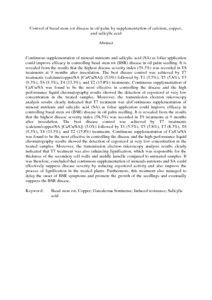Citation
Rahamah Bivi, M. Shahul Hamid and Paiko, Adamu Saidu and Khairulmazmi, Ahmad and Akhtar, M. S. and Idris, Abu Seman
(2016)
Control of basal stem rot disease in oil palm by supplementation of calcium, copper, and salicylic acid.
Plant Pathology Journal, 32 (5).
pp. 396-406.
ISSN 1812-5425
Abstract
Continuous supplementation of mineral nutrients and salicylic acid (SA) as foliar application could improve efficacy in controlling basal stem rot (BSR) disease in oil palm seedling. It is revealed from the results that the highest disease severity index (58.3%) was recorded in T8 treatments at 9 months after inoculation. The best disease control was achieved by T7 treatments (calcium/copper/SA [Ca/Cu/SA]) (5.0%) followed by T1 (5.5%), T5 (5.8%), T3 (8.3%), T6 (8.3%), T4 (13.3%), and T2 (15.8%) treatments. Continuous supplementation of Ca/Cu/SA was found to be the most effective in controlling the disease and the high performance liquid chromatography results showed the detection of ergosterol at very low concentration in the treated samples. Moreover, the transmission electron microscopy analysis results clearly indicated that T7 treatment was alsContinuous supplementation of mineral nutrients and salicylic acid (SA) as foliar application could improve efficacy in controlling basal stem rot (BSR) disease in oil palm seedling. It is revealed from the results that the highest disease severity index (58.3%) was recorded in T8 treatments at 9 months after inoculation. The best disease control was achieved by T7 treatments (calcium/copper/SA [Ca/Cu/SA]) (5.0%) followed by T1 (5.5%), T5 (5.8%), T3 (8.3%), T6 (8.3%), T4 (13.3%), and T2 (15.8%) treatments. Continuous supplementation of Ca/Cu/SA was found to be the most effective in controlling the disease and the high performance liquid chromatography results showed the detection of ergosterol at very low concentration in the treated samples. Moreover, the transmission electron microscopy analysis results clearly indicated that T7 treatment was also enhancing lignification, which was responsible for the thickness of the secondary cell walls and middle lamella compared to untreated samples. It was therefore, concluded that continuous supplementation of minerals nutrients and SA could effectively suppress disease severity by reducing ergosterol activity and also improve the process of lignification in the treated plants. Furthermore, this treatment also managed to delay the onset of BSR symptoms and promote the growth of the seedlings and eventually suppress the BSR disease.
Download File
![[img]](http://psasir.upm.edu.my/55381/1.hassmallThumbnailVersion/Control%20of%20basal%20stem%20rot%20disease%20in%20oil%20palm%20by%20supplementation%20of%20calcium%2C%20copper%2C%20.pdf)  Preview |
|
PDF (Abstract)
Control of basal stem rot disease in oil palm by supplementation of calcium, copper, .pdf
Download (6kB)
| Preview
|
|
Additional Metadata
Actions (login required)
 |
View Item |

